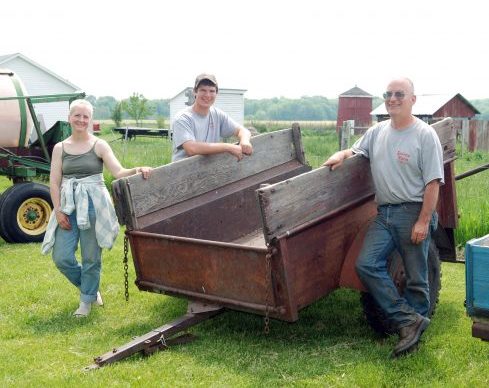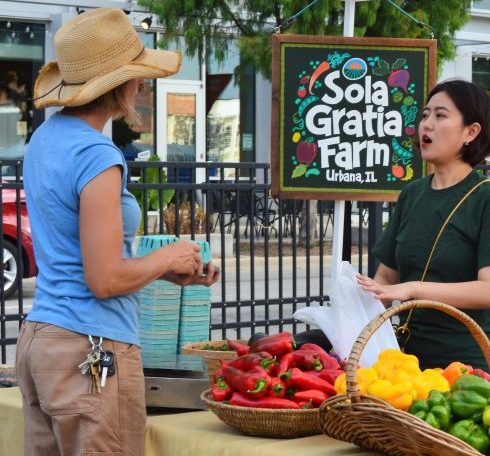While 60% of fresh-cut flowers grown in the U.S. come from California, almost 80% of fresh flowers sold in the United States are grown in Colombia, Ecuador, Mexico, the Netherlands, and Israel. Shipping flowers from those countries to the United States incurs huge transportation, energy, refrigeration, and storage costs, leaving an enormous carbon footprint. Distance is distance, just because it crossed an international boundary, doesn’t mean that it incurred a larger carbon footprint.
Imported and long-haul transported flowers may also carry the residue of chemical pesticides or fungicides with them. These flowers are often cut a week or more before arriving at florists or into customer’s hands. This can lead to quality and vase life decline. What this all boils down to is, buy flowers locally.
Locally-grown flowers are often more diverse in color, form, and scents (so they smell better!). Illinois has a magnificent array of flowers that will happily grow here, including many native and heirloom flowers that are not common in floral shops that only purchase from California or International growers. Purchasing from a local flower farmer also allows you to ask questions about how they grow things, what chemicals they might use, their farming philosophy and, importantly, how they encourage and protect pollinators and their habitats.
General Care
Follow these simple steps for keeping fresh flowers beautiful! First, cut at least 1/2 inch off of each flower stem and put in fresh water in a very clean container. The water should be just above room temperature, but not too warm. The flowers should not be too constricted by the vase, as this can lead to mildewing in the vase, especially if you don’t change the water frequently. You can also add a crushed up regular Aspirin to your water to make your flowers last longer. If you change the water frequently, add more crushed aspirin each time you change the water. Keep away from direct sunlight and drafts, change the water daily, if possible, and remove blooms as they wilt.
Edible Flowers
There are some really wonderful flowers out there that are edible and can be used to brighten up dishes and drinks all year round. Some common edible flowers include nasturtium, bachelor’s buttons, marigolds, calendula, roses, lavender, bee balm, sorrel, honeysuckle, mint, oregano, thyme, cilantro, dill, wild violets, squash blossoms, borage, basil and chives. They can be enjoyed fresh in salads, iced tea, or cocktails; or added to butter and baked goods (typically after being dried). One fun trick that will wow your guests is add fresh blossoms or herb leaves to ice cube trays, fill the trays with water, and put them in the freezer. You then have beautiful floral ice cubes for summer cocktails, wines, sangria, teas, water, or spritzers. Get creative!
Storage & Preservation
There are a few ways that people typically like to store or preserve flowers. Petals and buds can be dried and used later, or stored fresh for later use.
Dehydrating: Harvest individual blooms or petals and place on dehydrator screens in a single layer. Set dehydrator to 120°F and let it run for several hours. Check progress frequently and remove dried blossoms or petals.
Storing Fresh: Place fresh blossoms loosely in a Ziploc bag with a damp paper towel and blow air into the bag before sealing it so the blossoms don’t get crushed. Place the bag in the refrigerator for 1-2 weeks.
To dry flowers to use in dried flower arrangements, strip excess foliage from flowers and cut stems to the desired length. Hang flowers upside-down from a hanger, either individually or rubber-band the stems together. Hang in a dark, dry area with good circulation. Leave flowers for two to three weeks until completely dry. Remove from hangers and spray with unscented hairspray for protection.
Teas & drinks: add fresh or dehydrated flowers such as chamomile, rose, bee balm (sometimes called bergamot), coneflowers (also called echinacea), etc to hot water and allow to steep for several minutes until your tea reaches the strength you’d prefer. Flowers can also impart a lovely flavor to drinks, cocktails and especially lemonade!
Syrups & jams: Many fresh, edible flowers make delicate and delicious syrups and jams. Using just the tender petals, pack a quart jar and gently top with boiling water. Allow to steep, covered, overnight. This strongly infused tea can then be used with your preferred pectin to create a simple floral jelly. To make a syrup, weigh your floral tea and add twice as much sugar, by weight. Simmer until the sugar fully dissolves and the mixture reaches 210-215 degrees F. Floral syrups make fun additions to drinks. Some, like wild violet syrup, even change color from purple to bright pink when added to lemonade!





